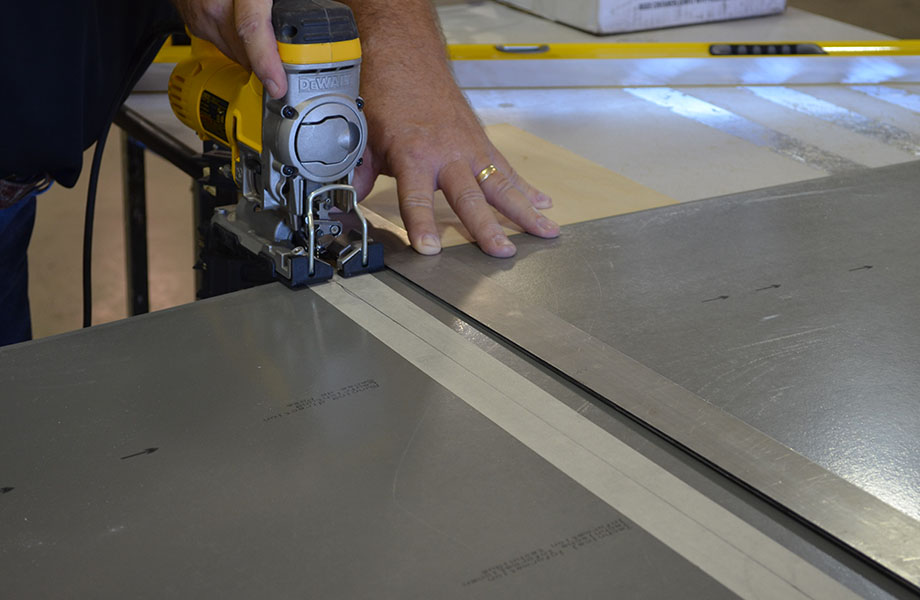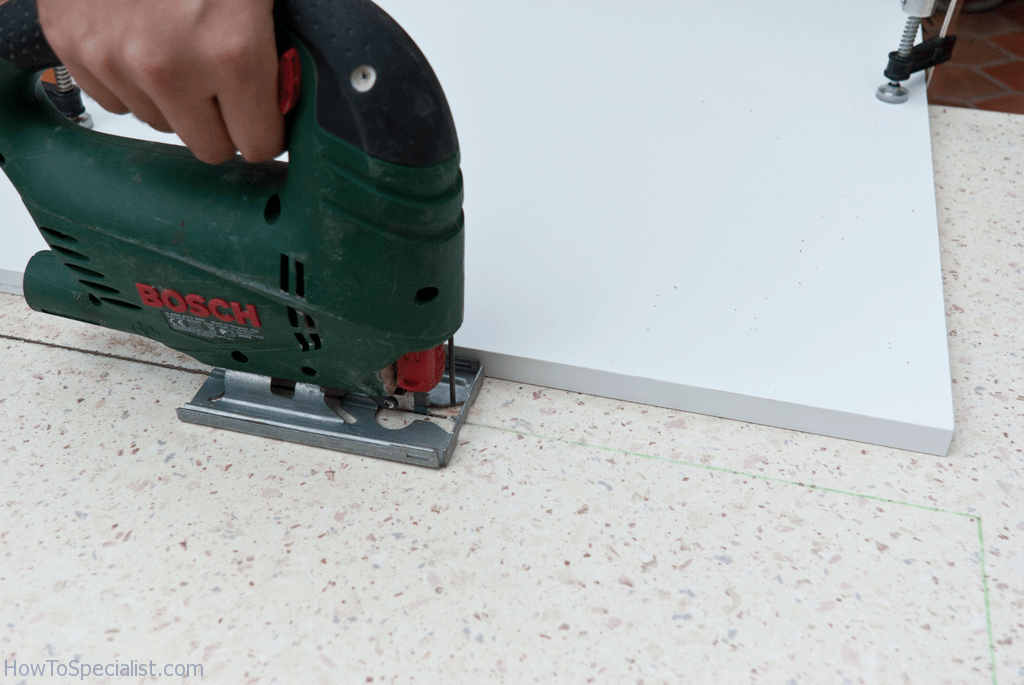Are you struggling to cut laminate countertops with a jigsaw? Want to find an easy, safe and effective way to do it? Look no further!
In this article, you’ll learn how to cut laminate countertops with a jigsaw the right way. Get ready to get those countertops looking great!
If you plan on installing a new countertop in your kitchen, but you don’t want to spend too much money, then one of the most cost-effective solutions out there is to install a laminate countertop. Laminate is an attractive and durable material that is much more affordable than granite or marble. The best part is that it can be easily cut with just a few basic tools. In this guide, we will teach you how to cut laminate countertops with a jigsaw. By following these steps, you will be able to save time and money by doing the installation yourself!
Laminate countertops are made from a sheet of laminated particleboard secured to the underlying cabinets and walls with adhesive caulk or liquid nails. They’re available in many different colors and styles, so you should have no trouble finding one that complements your existing decor. When cutting laminate countertops, it’s essential to take special care to ensure that the cuts are even and accurate for the best success.
Therefore, prior to beginning any cutting work on your laminate countertop project, it’s important that you have all the necessary safety gear (eye protection goggles and dust mask) while also doing some preparation beforehand like measuring twice so that you only have to cut once! A jigsaw is the perfect tool for making precise cuts into your laminate surface since its small size allows for easy maneuverability along curved edges or when attempting small details/designs along a straight cut edge as well! After completing this guide, you should be comfortable enough with using one of these tools effectively so that you may confidently begin on any future projects involving cutting into laminated materials such as arborite or Corian® etcetera.
Brief explanation of laminate countertops
Laminate countertops are a popular choice for many kitchens due to their affordability and low maintenance requirements. They are composed of multiple layers of plastic-like material that give the appearance of stone or granite, while still providing the superior durability and flexibility of plastic. These countertops come in a variety of styles and colors, allowing homeowners to customize their kitchen counters to match their décor.
Laminate countertops can also be cut with a jigsaw, providing an affordable DIY option for many kitchen remodels. In this guide, we will cover the steps for cutting laminate countertop with a jigsaw in order to ensure proper installation.

Importance of cutting laminate countertops accurately
Accurate and clean cuts of laminate countertops are critical to achieving a professional looking end result. Jigsaw is one of the most popular tools used to cut laminates as it ensures precise cuts and allows for curved patterns as well. Knowing how to make a jigsaw cut safely, accurately and quickly will help you achieve a perfect finish for your kitchen renovation that you can be proud of.
When making jigsaw cuts for laminate countertops, it is important to take into account any hard surfaces such as metal components or splintering edges that may be present in the area you are cutting. To prevent injury, use safety glasses, a dust mask and gloves when using your power tool. It is also important to go slow when cutting laminate countertops with a jigsaw; this will reduce any risk of kickback while producing accurate cuts. Additionally, clamp down your work piece with another solid object before beginning the cutting process. When making curved patterns or circles with your jigsaw, having a template beforehand can help ensure accuracy and precision.
Making precisely cut laminate countertops has never been easier with the use of a jigsaw! Following these basic safety tips and cutting strategies can help you achieve professional-looking results at home with minimal effort!
Preparing the Countertop for Cutting
Before you begin cutting the laminate countertop, you will need to prepare it for the saw. This will help ensure a smooth and clean line of cut.
First, use a ruler or straight edge to draw a line on the laminate where you will be making the cut using either a marker or pencil. This won’t be visible after the cut is made so don’t worry about how neat it looks.
Next, secure the countertop in place with clamps or tape to make sure it doesn’t move while you are cutting. This will also help reduce vibration from the saw which can cause wavy lines in your cut.
Finally, use sandpaper to rough up an area along the cutting path for better grip by your saw blade. Move in short strokes back and forth along the cutting path until you have achieved an even surface. Be careful not to sand too deeply as this could create depressions that may affect your ability to make a smooth cut.
With your countertop now ready for cutting, we can begin looking at techniques for making various cuts with a jigsaw:

Taking measurements and marking the countertop
Before you begin cutting your laminate countertop, you need to take some measurements, as well as mark all the spots you intend to cut. Doing this will help ensure that your cuts are accurate and that the final result looks great.
To get started, measure the area where the cut is needed, and write down or mark this data on a sheet of paper. Next, take a measuring tape and measure out exactly where each cut will go on the countertop itself. Then use a pencil to mark these points on the visible side of the countertop. Doing this step correctly is important since it will be more difficult to make adjustments later on in the process.
Finally, confirm that all your measurements are correct with another tape measure before you proceed with cutting it with a jigsaw.
Securing the countertop to a work surface
It is important to ensure that your countertop is secure while you work to avoid any potential accidents. The best way to do this is by securely clamping the countertop onto a sturdy work surface to prevent it from moving.
If you are cutting indoors, you can use C-clamps and if you are working outdoors, then use heavy-duty wood clamps. Once clamped into place, check for sturdiness and especially for any signs of movement.
If the countertop is not completely secure, it could be dangerous or impact the quality of your cut.
Cutting the Laminate Countertop
Once you have determined where your cuts will be made and prepped the area, you are ready to begin cutting the countertop. Here is what you’ll need to execute the cut correctly:
- A jigsaw
- An appropriate jigsaw blade for your type of countertop (e.g., a carbide-tipped blade for laminate)
- Safety glasses
- A dust mask
- A clamped straight edge, such as a scrap of plywood
- Painter’s tape.
Start by clamping your straight edge onto the countertop at a 90° angle so that it follows along your layout lines, providing a guide for the jigsaw to move inside its baseplate. This will help you make smooth turns, and it will protect the surface from scratches and chipping from the tool. Place painter’s tape along both sides of the curved edge of your cut line before starting; this will act as a dull “buffer” between your blade and countertop thereby reducing chips as well as protecting against scratches or divots in any part of the laminate material from coming in contact with or being caught in the baseplate recesses when turning curves or angles. Take great care moving around curves, taking slow continuous passes rather than rapid back-andforth motion that can cause more breakage to occur on tight arcs or circles. Go slow—just like cutting out a shape on construction paper with scissors—and make sure to raise up your blade periodically while cutting underneath surfaces; this procedure prevents buildup of excess material on top of the blades teeth that may cause abrasions on delicate surfaces during reverse movement transitions when exiting sharp cuts or turns in either direction (e.g., downstroke circles). When finished cutting, gently remove any residual dust particles left over with a dry cloth before installing sinks or faucets into place.
Positioning the jigsaw for the cut
Making an accurate, straight cut with a jigsaw is even more difficult when working with countertops such as laminate. Therefore, it is important to position the jigsaw in the right spot before beginning. Positioning the saw correctly helps you to achieve clean and accurate results.
In order to position your jigsaw in the correct spot for a straight-line cut, start by drawing a cutting line on the countertop using a pencil and straightedge or ruler. It is also essential that the blade of your saw is perpendicular to both the cutting line on the countertop and to your workbench. If necessary, adjust any clamps used to secure the workpiece so that it will be steady as you make your cuts. If possible, use a trammel or other type of guide rail along with clamps for maximum accuracy.
Once set up and secured properly, turn on your saw’s power switch but do not engage the blade yet. Move it slowly into the line you’ve drawn until it just touches the material you are cutting at all points along its length – this will help ensure an even finish throughout. Once you are sure that you have adjusted everything correctly, press down on your saw’s trigger switch to engage its blade before making your cut.
Starting the cut and maintaining a steady pace
Before you begin cutting, make sure that your countertop is secured in place. Use a strip of masking tape and a ruler to create a straight line so that your saw will follow. Use the jigsaw’s laser guide or its built-in straightedge to help guide your cut.
Once you’re ready to start cutting, turn on the saw and hold it firmly against the laminate countertop. Maintain a steady speed of around one thousand revolutions per minute (RPM) for best results. As the blade moves across the surface, make sure to keep it as even as possible to ensure an accurate cut line. You may need to reduce your speed for tight corners or areas with curves.
When moving around curves or tight corners, press down on the handle firmly so that the blade does not wander away from its intended course. To finish off any cuts and create clean lines, run over them multiple times with a smooth motion while exerting minimal pressure on the blade’s handle. After you’re finished, apply some laminate sealant along the edges of your new section of countertop to keep it looking beautiful for years to come!

Conclusion
In conclusion, cutting laminate countertops with a jigsaw is a reasonable and effective method of making straight cuts and tight curves in countertops. Although more specialized tools can provide cleaner, more consistent results, they are much more expensive than a jigsaw and may not be necessary for the average do-it-yourselfer. With the right tools and a little patience, you should be able to cut beautiful, accurate laminate countertop shapes that you can be proud of.
FAQS
What is the best tool to cut laminate countertops?
The best tool to cut laminate countertops is a circular saw with a fine-toothed blade, a jigsaw with a laminate cutting blade, or a router with a laminate cutting bit.
What kind of jigsaw blade to cut laminate countertop?
To cut laminate countertop with a jigsaw, use a jigsaw blade specifically designed for laminate cutting. A blade with a downstroke tooth design, a fine-tooth count, and carbide tips is recommended.
What is the best way to cut laminate countertops?
The best way to cut laminate countertops is to use a circular saw or jigsaw with a fine-toothed blade, and to cut slowly and carefully to avoid chipping or cracking the material.
Which way do you cut laminate worktop with a jigsaw?
When cutting laminate worktop with a jigsaw, cut from the top of the worktop with the good side facing down. This helps to prevent chipping and ensures a clean cut.
How can I cut laminate without chipping?
To cut laminate without chipping, use a fine-toothed blade on a saw or jigsaw, and cut slowly and carefully. You can also use masking tape on the cutting line to help prevent chipping.
How do you cut laminate countertops without cracking them?
To cut laminate countertops without cracking them, use a saw or jigsaw with a fine-toothed blade, and cut slowly and carefully. Supporting the material with a backing board can also help prevent cracking.
How do you cut a countertop without chipping it?
To cut a countertop without chipping it, use a saw or jigsaw with a fine-toothed blade, and cut slowly and carefully. Supporting the material with a backing board or using masking tape can also help prevent chipping.
How do you cut solid laminate countertops?
To cut solid laminate countertops, use a saw or jigsaw with a fine-toothed blade and cut slowly and carefully. Support the material with a backing board and use masking tape on the cutting line to help prevent chipping.
Can you cut laminate countertop with scissors?
No, scissors are not suitable for cutting laminate countertops. A saw or jigsaw with a fine-toothed blade is recommended for cutting laminate countertops.
How do you cut laminate worktops by hand?
To cut laminate worktops by hand, use a straightedge or guide and a sharp utility knife to score the surface of the laminate. Then, snap the material along the scored line.
See Also:
- Best jigsaw blades for laminate flooring
- Best jigsaw blades for metal
- Best jigsaw blades for plywood
- Best jigsaw blades
- Best jigsaw for cutting curves


